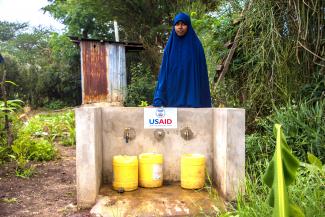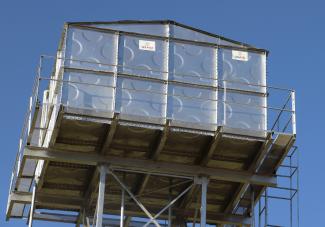Access to Water Enhancing Household Nutrition in Northern Kenya
“Water was a big challenge and we could not grow anything. We could not afford water for planting. We had to buy 50 liters of water daily at KES 500 (USD $4) to cater to our household needs when the river dried up. There were times I had to choose between buying food or water. When I bought water, I would prepare rice only for my family, which I knew wasn't a balanced diet,” Shinda said.
Shinda Abdi lives with her four children in Mabatini village in Bulapesa ward, an urban settlement in Isiolo County. The residents relied heavily on three water sources that were not fully accessible.
An unprecedented drought in the Arid and Semi-Arid Lands (ASALs) of Kenya, marked by five consecutive below-average rainy seasons, impacted people living in 23 counties including Garissa, Isiolo, Marsabit, Samburu, Turkana, and Wajir. The drought led to scarce water sources, famine, livestock migration, natural resource degradation, and weak economic performance. According to the National Drought and Management Authority by March 2023, 4.4 million people were facing hunger as 2.6 million livestock starved to death.

First, the Isiolo River dried up. Second, a water pipeline from the county water service provider could only reach a few homes. Third, the Mabatini borehole, constructed with a solar pumping system and a 300 cubic meter masonry tank was only accessible to people living close to it. Inadequate access to water in the locality led to food scarcity and high prices. During the drought, Shinda spent KES 492 ($3.5) a week on vegetables to serve with maize meal but with little rain received in the first half of 2023, the cost was reduced to KES 281 (USD $2). Even so, the food was not enough and her children complained of hunger.
In 2023, the United States Agency for International Development through Feed the Future Kenya Livestock Market Systems Activity (LMS) worked hand-in-hand with the county government of Isiolo and the Bulapesa Ward Planning Committee to improve access to water and enable small-scale farmers, such as Shinda, to grow crops.
LMS constructed a 32 cubic meter elevated water tank at Mabatini village, where Shinda lived, before installing a 1.2 kilometer pipeline from the existing borehole to the tank and a water point at Mabatini village serving 500 households with access to clean water. The pipeline extension also provided an opportunity for residents to connect tap water to their families. With easy access to clean water, Shinda started a kitchen garden with maize, pawpaws, and vegetables such as sukuma wiki or kale, tomatoes, and pumpkin. She could now provide her family with a balanced diet and is saving money on vegetables from the market.

“My children’s favorite vegetable is kale mixed with pumpkin leaves. They enjoy it and it is nutritious. Were it not for the water, I would not have planted any of these,” said Shinda.
Shinda also mentors her daughter in gardening and chicken rearing. They use the chicken manure in the kitchen garden. With a good harvest of maize, Shinda will have enough for her family and sell the surplus which she will use for food and to pay school fees for her children.
USAID through its LMS activity and in collaboration with the nation and county governments increased access to clean water for 14,328 people and their livestock between October 2022 and May 2023 as well as supporting the rehabilitation of 40 community water projects. This included rehabilitating existing borehole systems, installing new pipelines, rehabilitating or constructing new water kiosks, introducing a solar-powered borehole pumping system, and desilting water pans. The activity is in line with Kenya's Vision 2030 of ensuring that improved water and sanitation are available and accessible to all Kenyans by 2030. To date, 28 million Kenyans out of a population of 53 million lack access to safe water.

